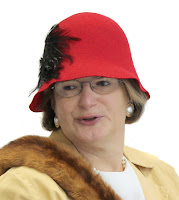 |
| Why does Liz look like Jaguar? Keep reading! |
I have been to 4 NSN Conferences over the past 15 years and enjoyed each in its own way. Of course it’s great to reconnect with folks and feel continuity, but for me discovering something or someone new and different is always the highlight.
At this year’s Conference one thing that was new to me was the programming of swaps and fringe performances concurrent with the workshop sessions. The idea of missing a workshop to attend a swap or fringe was tough for me, but I did it several times, and on Saturday afternoon I hit the jackpot. I’d already picked up “gig postcards” for various Fringes (just that self-promotional practice felt like the wider theater arts world permeating the storyteller atmosphere), and I couldn’t resist the sight of Christopher Agostino in the hotel hallway outside his session space, prepping the biggest, most colorful, most artsy box of face paints I’ve ever seen. When I heard the NYC accent from my hometown, that clinched it.
The show was called “Before Cave Walls... The Story on Our Skin”. Here’s what Christopher’s website (http://www.agostinoarts.com ) says about what he does:
Agostino & Co. Performing Arts presents exciting, innovative performances and entertainment for family audiences. We employ storytelling, movement, clowning, masks and costumes, sound and text, and "Transformation! Facepainting" to create original theatre which is both thought-provoking and entertaining for schools, theatres and events. Our "Transformation! Artists" are regularly seen at events and parties throughout the New York area turning thousands of people each year into fantastic works of art.
About 25–30 of us sat mesmerized as he started with a lecture/demo on the human history of self-transformation through mask and body art, calling up volunteer after volunteer to be painted as he talked. Then he wove several stories in, some traditional and some in a folktale mode that he and his kids had created – and he used us as his canvas to show characters like jaguar, snake and lizard, and settings like tropical island and African savannah.
While the performance itself was terrific, even more fun was the way those of us who volunteered became an instant family of sorts. Some of us decided to go to dinner together at a nearby restaurant, where we got lots of stares and some great conversations. Even Charlotte Blake Alston got up on stage for her Oracle Award presentation duties in her face paint, and at the reception that followed it was surreal to chat and sip wine, slipping in and out of the awareness that people seeing me were actually seeing Jaguar instead.
The larger importance of all this for me boiled down to a couple of insights:
1) That it took an “oddball” experience for me to make a very special connection with a group of people who didn’t know each other at all before the conference. It transcended the usual categories we fall into.
2) The value of truly opening up our storytelling world to allies and friends with different backgrounds and identities – those for whom “storyteller” is a secondary aspect of their art and work.
Christopher told us that he had not been sure he would be welcome—he wouldn’t have come except that his Fringe application had been picked out of the hat. I’m glad to say he got a great response. It was an example of what Bill Harley talked about in his very thought-provoking closing address—that for the broader world, storytelling may be better recognized and valued as a “seed art” than stand-alone. And that rather than always complaining about that, we should see it as a positive, as a bridge.




